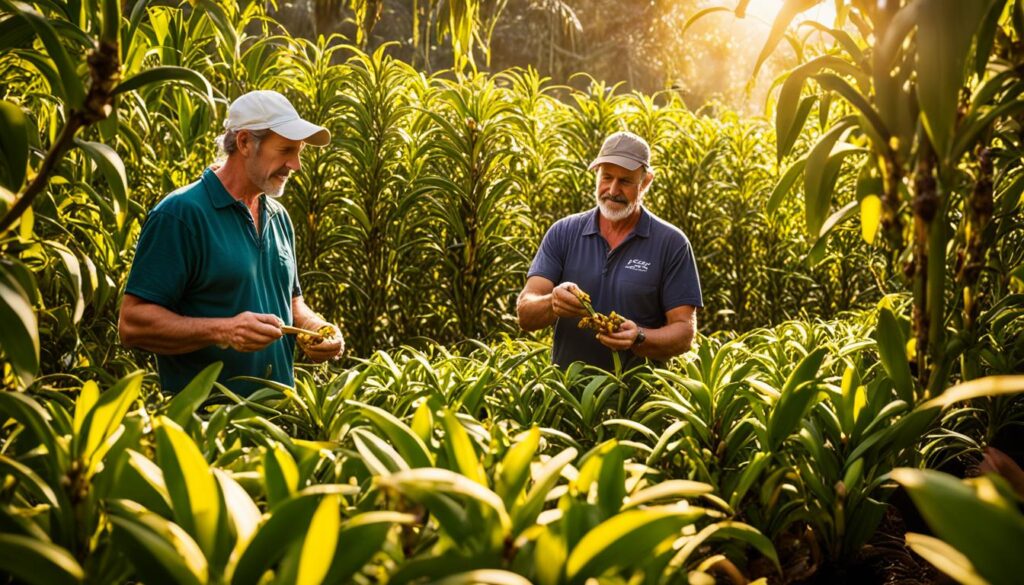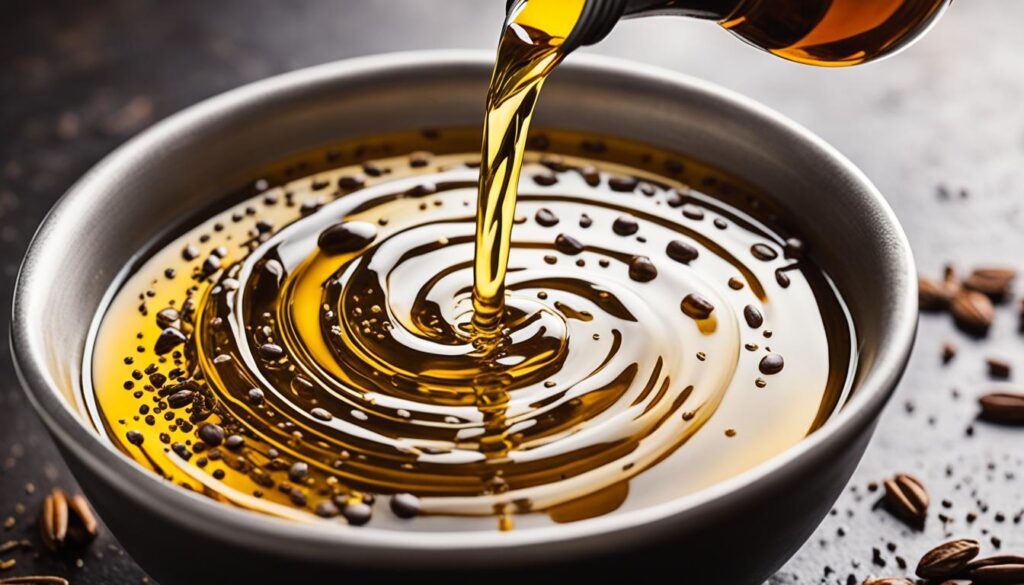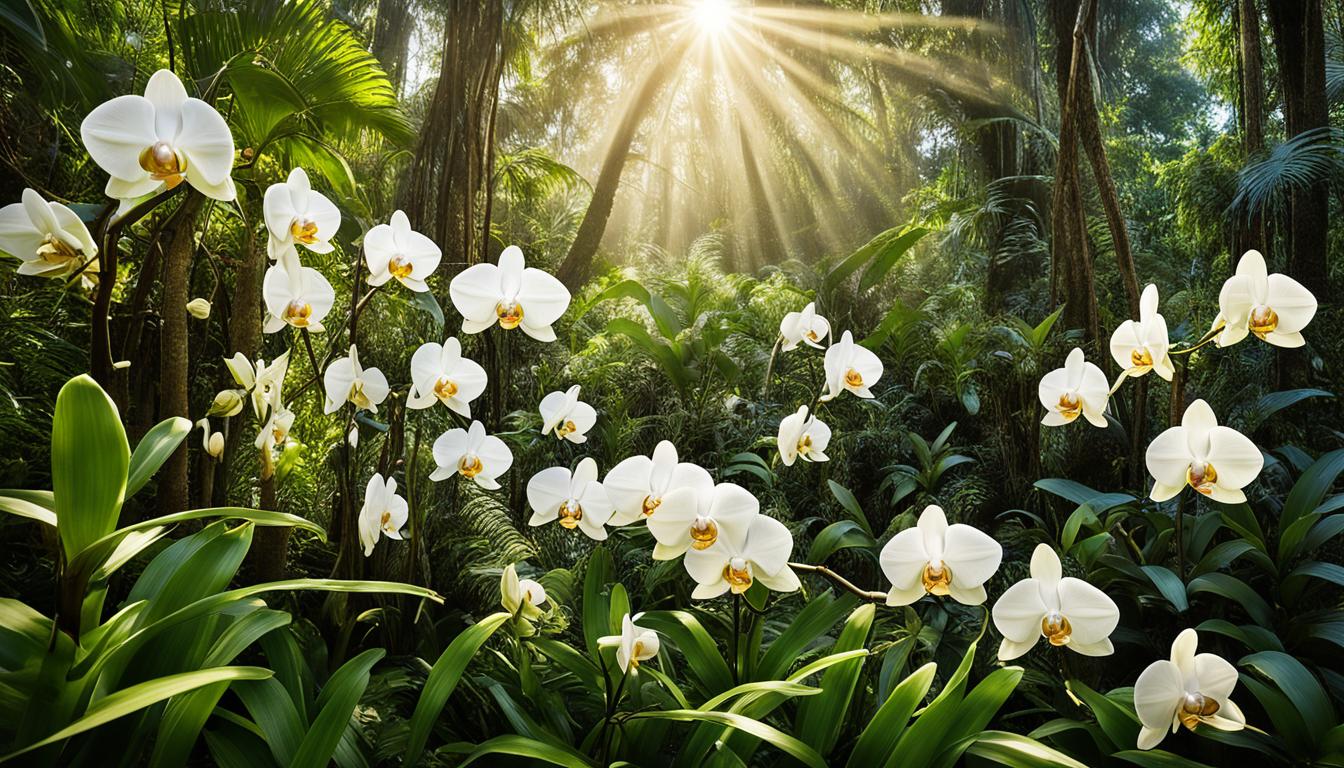Every second, somewhere in the world, a consumer is entranced by the enchanting aroma of vanilla orchids, a fragrance so pivotal to perfumery that it is included in over 18,000 perfumes globally.
Quick Facts
| Characteristic | Detail |
|---|---|
| Countries of Origin | Tropical areas of Central and South America, the Caribbean, and Southeast Asia |
| Colors | Flowers are typically greenish-yellow to creamy white, with a pale or yellowish lip |
| Size | Vining orchid that can grow very long, often several meters in cultivation |
| Difficulty To Grow | Moderate to difficult, requiring specific conditions and patience for flowering and vanilla production |
| Bloom Season | Varies by region; flowers bloom in spring and summer, but timing can be specific to local climates |
| Light Requirements | Bright, indirect light; tolerates some direct light in the morning or late afternoon |
| Watering Needs | Consistent moisture needed, especially during active growth; less water during dormant periods |
| Temperature Range | Prefers warm conditions; daytime temperatures of 80-95°F (27-35°C) and nighttime above 60°F (15°C) |
| Potting Medium | Requires a support to climb; can be grown in soil or on tree trunks in humid conditions |
| Propagation Methods | Cuttings from the vine that include several nodes; also by air layering |
| Common Pests and Diseases | Susceptible to pests such as aphids, mealybugs, and diseases like root rot in overly wet conditions |
| Fragrance | Flowers are fragrant, with a sweet and delicate scent |
| Lifespan/Longevity | Can live for many years, even decades, with proper care; individual flowers last a very short time |
| Conservation Status | Not generally endangered but habitat loss affects wild populations; Vanilla planifolia is widely cultivated |
| Unique Features | The only orchid commercially grown for its edible fruit; the source of natural vanilla flavoring |
I am thrilled by this universally beloved treasure, a testament to nature’s essence and its ability to captivate the human spirit. Beyond the luxurious scent lies a world of intensive cultivation and labor, heightening my appreciation for nature’s temptation.
As I embark on exploring the journey of vanilla orchids, from their tropical beginnings to the heart of sumptuous perfumes, I’m eager to share the allure that has tantalized the senses for centuries.
Not only do these delicate florals introduce a sense of comfort and indulgence, but they also invite us to discover the intricate processes behind their growth and aroma extraction.
With regions like Madagascar and Tahiti as their cradles, vanilla orchids symbolize both luxury and a dedication to ethical and sustainable sourcing, commitments that resonate deeply with me and like-minded enthusiasts of this irresistible aroma.
Key Takeaways
- Vanilla orchids’ enchanting aroma is a cornerstone in global perfumery, with their scent featuring in thousands of fragrances.
- The growth of these precious flowers represents a labor of love that signals both luxury and a dedication to sustainability.
- Madagascar and Tahiti are renowned for cultivating vanilla orchids, where ethical practices are central to their production.
- The luxurious scent of vanilla is as much about its cultivation as it is about its ubiquitous presence in nature’s aromatic palette.
- Recognizing vanilla orchids involves appreciating the connection between their alluring scent and the careful, sustainable practices that bring it to life.
The Enchanting History of Vanilla Orchids
The allure of the vanilla orchid is one steeped in a rich historical tapestry that begins with the Aztecs and vivaciously blooms in the palatial corridors of European courts.
My exploration into the past unravels the profound influence of this scent that has captivated nostrils and hearts for centuries. The tale of vanilla is a sensorial delight, linking the aromatic to ancillary traditions and the legendary craftsmanship of perfumery.
As I relish this journey, I find myself astounded by the complex odyssey of a simple pod that redefined taste and fragrance.
The Aztec Origins and European Love Affair
Long before Aztec chocolate drinks were enhanced with the sweet essence of vanilla, the Totonac people of Mexico regarded the vanilla orchid as a divine gift from the gods.
However, it wasn’t until the Aztecs conquered the Totonacs that vanilla was introduced to chocolate, spawning a match of decadent flavors.
This divine concoction bewitched the Spanish conquistadors, heralding vanilla orchids’ entrée into the illustrious salons and European courts.
The beguiling scent diffused across the Atlantic, making its mark as a symbol of luxury and opulence.
Vanilla’s Rise to Perfume Prominence
In the aromatic ateliers of France, French perfumers were experimenting with an assortment of essences to create olfactory masterpieces.
Recognizing vanilla’s potential as a base note in perfumery, they began to incorporate the sensual, warm undertones of vanilla into their concoctions.
This base note brought a revolutionary depth and complexity to their fragrances, ensuring that once a person was enveloped in a scent laced with vanilla, they were eternally captivated by its embrace.
From my perch in the present, I contemplate the panorama of vanilla’s legacy, from its ancestral use in sacred ceremonies to its valorization as the quintessence of worldly sophistication.
Vanilla has transcended its humble botanical beginnings to become a perennial favorite in the perfumer’s palette, a testament to its undying charm and versatility.
Cultivating the Alluring Vanilla Orchid
The labor-intensive cultivation of vanilla orchids is as fascinating as the enchanting scent they yield. Perfect growth conditions are found in tropical climates, which provide the high humidity and warm temperatures vanilla orchids crave.
In areas like Madagascar, the world capital of vanilla production, these conditions are met, and as a result, Madagascar is renowned for its high-quality beans.
One of the most intriguing aspects of vanilla orchid cultivation is hand-pollination. Each orchid flower presents a limited window of opportunity, it blooms for just one day a year.
If that fleeting chance is missed, there will be no vanilla beans to harvest. Skilled laborers meticulously perform the delicate task of hand pollination, ensuring that the plants are fertilized and able to produce the coveted vanilla pods.

The journey from pollination to the final product is an exquisite exercise in patience and care.
Vanilla bean harvesting is more than just picking pods; it’s a complex sequence of processes, including blanching, fermenting, and drying under the sun, the methods that foster the development of the distinct vanilla flavor profile.
| Stage of Cultivation | Process | Duration |
|---|---|---|
| Hand-pollination | Manual fertilization of flowers | 1 day each year |
| Bean maturation | Growth period post-pollination | 8-9 months |
| Harvesting | Collection of matured beans | Varies |
| Curing | Blanching, fermenting, drying | Several weeks |
Throughout the growth cycle, meticulous timing and manual labor converge to transform the orchid’s delicate blossoms into aromatic beans. For those engaged in the industries dependent on vanilla, like perfumery and gastronomy, the essence of these processes is a tale of nature, craft, and artistry yielding a treasure trove of senses, that all starts with the allure of a vanilla orchid flower in the fitting embrace of a tropical climate.
Transforming Vanilla Beans into Liquid Gold
The journey of vanilla beans from their orchid origins to becoming a quintessential element in refined fragrances is a testament to both nature’s alchemy and human ingenuity.
The entire process resonates with a touch of artistry, where traditional techniques intertwine with modern precision to create the prized vanilla oil extraction.
My fascination with the fermentation process stems from its pivotal role in teasing out the rich aroma of vanilla beans. This meticulous method does not merely amplify the scent, but it also allows it to evolve into the full-bodied essence that forms the heart of countless perfumes.
It’s a careful dance of temperature and time, coaxing the subtle nuances that make vanilla an enduring favorite.
Indeed, those with a discerning nose for scents can attest to the complexity and depth that vanilla introduces to a perfume’s bouquet.
The essence commands a presence, often serving as the foundation upon which other notes delicately balance.
But the true measure of vanilla’s value in perfumery can be quantified in the labor it requires: roughly three kilograms of vanilla beans are devoted for each liter of perfume essence.
Understanding this ratio unravels why vanilla is often likened to ‘liquid gold’ in the realm of scents.
| Vanilla Bean Quantity | Vanilla Oil Yield | Important Notes |
|---|---|---|
| 1 kg | 300-333 ml | Initial sun-drying stage is crucial for moisture reduction. |
| 2 kg | 600-666 ml | Fermentation duration varies depending on bean size and moisture content. |
| 3 kg | 1 liter | Blanching prior to fermentation halts germination and ensures quality. |
It’s not merely these figures storytelling but the hands behind every step of this delicate procedure.
Each bean unfolds into a narrative of tradition, craftsmanship, and the pursuit of aromatic excellence.

As I explore the influence of vanilla in the olfactory world, I’m met with a newfound appreciation not just for its captivating scent, but also for the journey it undertakes to reach our senses.
In essence, the crafting of vanilla into a perfume is no less than alchemy – turning the natural bounties into a sensory gold that defines luxury and comfort in scents.
The Eternal Dance of Sustainability and the Vanilla Industry
As the world turns its attention to the fragrant fields of vanilla orchids, it’s crucial to spotlight the efforts made toward Sustainable Vanilla Production.
The delicate journey from flower to fragrance is intertwined deeply with practices aiming to safeguard both the people behind the produce and the planet we call home.
Sustainable Practices in Vanilla Cultivation
Striking a chord with environmental health, vanilla cultivation is increasingly embracing Agroforestry. This system creates a mutual benefit for the flora and the farmers.
Surrounding vanilla plants with diverse tree species not only protects them from harsh weather and pests but also improves the fertility of the soil, fostering a thrumming, biodiverse landscape.

Supporting Farmers Through Ethical Sourcing
In the world of vanilla, every capsule brims with stories of labor and livelihood. By committing to Fair Trade principles, we ensure that this opulent spice yields not only a rich aroma but also a wealth of welfare for the cultivators.
With fair prices and ethical labor practices, every purchase of vanilla endorses a life of dignity for the stewards of these precious pods.
Impact of Climate and Agricultural Methods on Vanilla Orchid Production
Vanilla orchids are delicate dancers in the grand performance of agriculture, sensitive to the slightest changes in weather and the condition of their soils.
Organic Farming practices have emerged as lead performers, helping mitigate negative climatic impacts by avoiding synthetic fertilizers and pesticides, promoting a healthier ecosystem for the orchids to thrive.
| Agroforestry Benefits | Fair Trade Principles | Organic Farming Practices |
|---|---|---|
| Enhanced biodiversity | Equitable pay for farmers | No synthetic chemicals |
| Improved soil fertility | Support for community projects | Conservation of local wildlife |
| Protection from winds and heavy rain | Transparent company-farmer relationships | Sustainable soil management |
In synthesizing these practices, the vanilla industry pirouettes gracefully towards a future where scent and conscience are in harmony.
Through preserving the essence of this timeless treasure, I advocate for a world where the production of vanilla uplifts and respects all elements in its circle of life.
Conclusion
The universal appeal of vanilla, with its warm embrace and seductive qualities, traces back through the annals of time, illustrating the profound impact this wonder of nature has had across various cultures and societies.
I have seen how the cultivation and utilization of vanilla orchids have evolved, from the Aztecs’ revered flavoring agent to a symbol of luxury within the realm of environmentally conscious perfumery.
The symbiotic relationship that has unfolded between humans and this tantalizing essence reverberates through the ages, culminating in a fragrance that is cherished worldwide as a unisex fragrance, dissolving the barriers of gendered scents.
Today, as I examine the strides made toward ethical and sustainable practices, the importance of vanilla orchids in perfumery becomes even more pronounced.
By fostering environmentally conscious approaches to vanilla cultivation, we reinforce the link between nature’s bounty and responsible enjoyment. My understanding of vanilla’s role has matured, recognizing that it goes beyond olfactory pleasure, serving a higher purpose in harmonizing economic viability with the health of our planet.
This is the new narrative I embrace, where the luxurious scent I know and love is also a testament to humanity’s potential for positive impact.
In my journey through the intoxicating tale of vanilla orchids, I have grown ever more cognizant of the dedication behind each aromatic drop that graces our senses.
My appreciation deepens for the labor of love that transforms the orchid’s delicate flowers into the captivating notes present in my favorite fragrances.
Ultimately, it is this captivating journey from plant to perfume that highlights the intersection of allure and responsibility, guiding my choice to support fragrances that not only appeal to my senses but also to my commitment to an environmentally considerate world.
FAQ
What makes vanilla orchids so captivating?
Vanilla orchids are seductive due to their enchanting aroma which has been considered nature’s essence of temptation for centuries. Their luxurious scent is a key ingredient in perfumery, known for its sweetness and comforting, long-lasting nature.
Can you tell me about the history of vanilla orchids?
Vanilla orchid’s origin dates back to the Aztecs, who used it to flavor their chocolate drinks. It captivated European courts after the Spanish conquest and became a base note in perfumery in the 18th century, thanks to French perfumers recognizing its potential.
Where are vanilla orchids predominantly grown?
They thrive in tropical climates with high humidity and warm weather. Madagascar is particularly famous for its vanilla production and has become synonymous with high-quality vanilla beans.
What is involved in the hand-pollination of vanilla orchids?
Hand-pollination is a labor-intensive process that involves manually pollinating the flowers on the one day they bloom each year. It requires precision and dedication to ensure the growth of the vanilla beans.
How are vanilla beans transformed into the essence used in fragrances?
After harvesting, vanilla beans are blanched to halt germination, carefully fermented to develop their characteristic scent, and sun-dried. The rich aroma is then extracted into an oil, which is a concentrated essence used in perfumes.
Why is sustainable vanilla production important?
Sustainable vanilla production is crucial for maintaining environmental health and supporting local farmers. Practices such as agroforestry and engagement in Fair Trade and organic farming help to foster ethical labor and healthier ecosystems.
How does ethical sourcing of vanilla support the farmers?
Ethical sourcing ensures farmers receive fair compensation for their work, which is especially important given the intensive labor involved in cultivating and harvesting vanilla orchids. This also promotes social and economic sustainability in farming communities.
How do fluctuations in climate impact vanilla orchid production?
Vanilla orchids are sensitive to climate changes, and uncertainties can severely affect yield and quality. This, coupled with market fluctuations, presents ongoing challenges for sustainable vanilla cultivation and requires adaptive agricultural methods.
Why is vanilla considered a unisex fragrance?
Vanilla’s universal appeal transcends gender, making it a favorite in both men’s and women’s perfumery. It offers a sweet yet complex scent that harmonizes with a variety of fragrance notes, thereby suiting everyone’s taste.


Leave a Reply